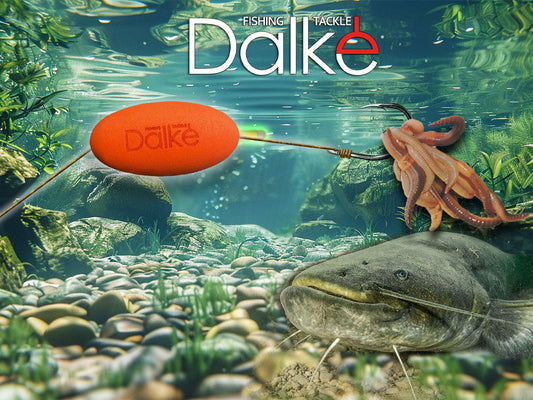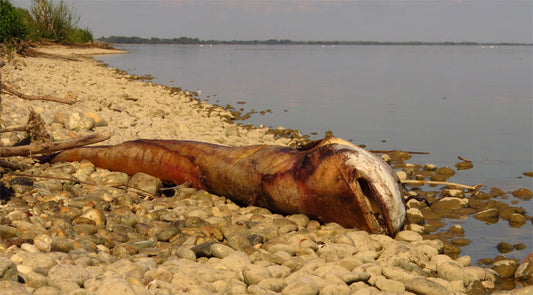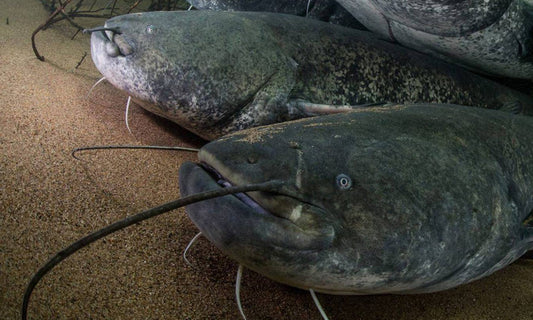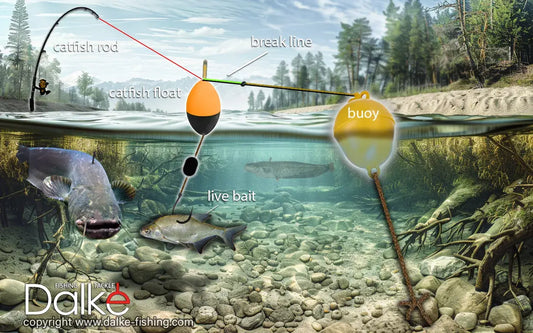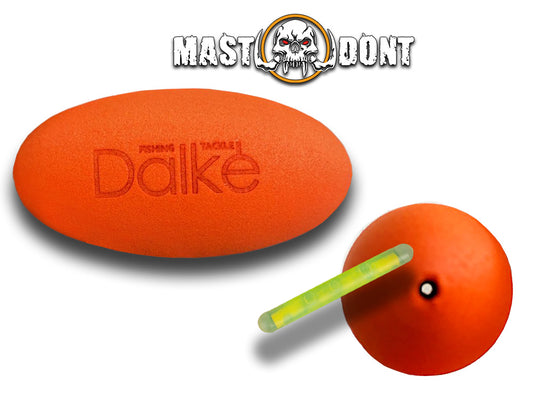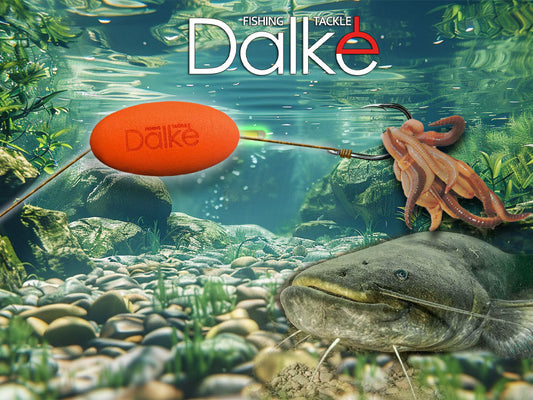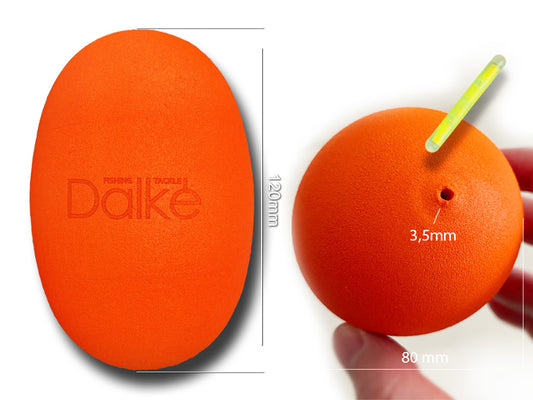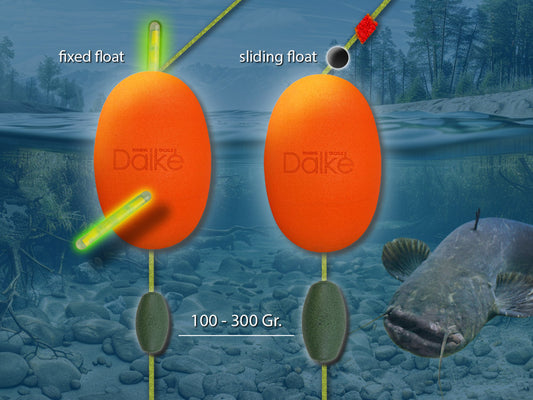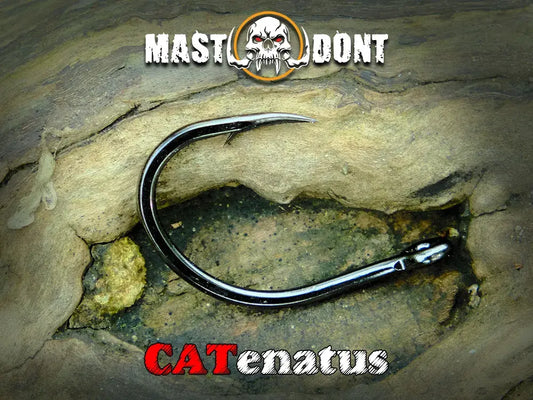
Catfish fishing with an underwater float (Subfloat). The evolution of the catfish bottom rig.
Vitali DalkeShare
Welcome, dear fellow anglers!
Today I would like to talk about one of the most significant improvements in bottom fishing for catfish – the Subfloat .
In the many years I have spent on the waters, I have realized that striving for perfection in equipment, rigs, and fishing methods is the key to success.
My own brand, Dalke Fishing, was created precisely to share these experiences with you and offer you proven solutions that really work.
Classic ground fishing for catfish is familiar to every catfish angler. But even classic methods need further development to adapt to changing conditions and fish behavior. Let's understand why the catfish subfloat has become not just an addition, but a very important element of the modern bottom rig.
From classic to innovation: The evolution of the Wels Catfish basic rig
Let's start with the basics. The classic bottom rig is simplicity and reliability. It consists of a running lead, a sturdy swivel, and a 50-100 cm leader with a single hook or a multi-hook rig. A simple bottom rig can be effective in early spring or late fall, when the water is cold and the catfish becomes sluggish. During such periods, they don't always hunt actively, sometimes even preferring to gather food from the bottom—clams, dead fish, crabs. The bait lies on the bottom and is easy prey.

I caught this large catfish on a large reservoir using a classic bottom rig on a dead fish lying on the bottom. Due to the heat and low oxygen levels in the water, the catfish were inactive and unable to hunt live fish. Likewise, many whitefish suffocated and died. Under these conditions, I realized how and what I needed to fish for.
Despite its effectiveness under certain rare conditions, the classic bottom rig has its limitations. This becomes particularly clear when fishing with live fish bait or in currents. The bait on a classic bottom rig often crawls to the bottom, hides in aquatic plants, or simply lies motionless, making it unattractive to predators. In currents, a bottom-lying bait cannot optimally spread its scent and does not generate the necessary vibrations.
It was precisely these limitations that led to the emergence and widespread use of the "bottom rig with subfloat" in catfish fishing.
Why do you need an underwater float (Subfloat)?
Switching to a bottom rig with an subfloat isn't just a small change; it's a fundamental improvement that significantly increases our chances of success. The principle is the same, but the leader length is increased to 80-170 cm. A special float is attached 15-20 cm from the hook, ensuring the bait floats above the bottom. The subfloat must be securely attached and must not slide along the leader, usually with rubber stoppers or stop knots.

Ideal presentation of the bait:
The catfish is a predator that doesn't always seek its food directly on the bottom, as many believe. It often patrols the near-bottom and middle layers of water. The subfloat raises your bait above rocks, aquatic plants, and mud, making it as visible and accessible as possible for the catfish. The bait doesn't get lost in the mud, but is directly in the predator's "field of vision."
Dynamics and attractiveness of the bait fish:
This is arguably its greatest advantage. Where live bait is permitted, the subfloat becomes absolutely indispensable. Unlike the static bait on a classic bottom rig, the subfloat constantly pulls the bait upwards. The bait, instinctively trying to escape to the safer zone near the bottom, is forced to constantly move. This continuous "bustling" creates active oscillations and vibrations in the water, attracting catfish even from great distances. Catfish have exceptional hearing and the ability to sense the slightest water movement, and it is precisely these distress signals that make the bait with an subfloat irresistible.
Important note: In still water, the baitfish should be hooked close to the tail so that it constantly tries to swim away from the float and generates maximum activity. In currents, however, it's better to hook the baitfish through the upper lip so that it moves naturally in the current.
I used to often use a rig with two hooks: a single hook and a treble hook. Over the years, I've completely abandoned the use of treble hooks. Now I use a rig with two single hooks, and lately I've been experimenting a lot with a large single hook, but we'll talk about that in another, separate article.
Effective odor dispersion:
In waters with a current, a bottom rig with an subfloat offers enormous advantages. Using worms, dead fish, or fish scraps will make the bait "play" attractively in the current. This movement not only makes the bait more visible but also spreads its scent much more effectively than a bait lying motionless on the bottom. The scent of the bait is carried long distances by the current, attracting catfish from a wide area.
Variety in bait presentation:
The subfloat offers the unique opportunity to regulate the bait's presentation depth. For example, if you use a sliding rig and let the line run out, you can present the bait at half water depth or even just below the surface, thus adapting to the catfish's current behavior. This allows you to catch catfish that may move to the upper layers of the water in search of food, for example, in hot weather or during insect activity. I'm not a fan of the sliding rig and in such cases simply tie a long leader of 2-2.5 meters.

Further evolution of the basic assembly: stone and break line
Long-standing practice of catfish fishing has revealed significant disadvantages in using sliding weights under certain conditions. This often led to numerous missed bites when the catfish could "spit out" the bait after the bite without swallowing it completely, or conversely, swallowed the bait too deeply, making it difficult to unhook the fish and potentially harming it. Furthermore, in strong currents, overly heavy weights were often required. These were difficult to cast and position accurately and could easily be moved by the current, causing the rig to be carried away from a promising spot. Clearly demonstrating these specific problems with traditional rigs (missed bites, deep hook swallowing, insufficient weight for strong currents) is crucial. It paves the way for the once innovative solution and demonstrates a critical, analytical approach to angling challenges.
Precisely because of these problems, catfish anglers once came up with the idea of using a heavy rock (between 3 and 8 kg) as a fixed weight on a break line. This approach allows for precise positioning of the rig: we can move it by boat exactly where we want it, confident that it will stay put despite any current.
The stone is wrapped with a cord made of natural fibers (sisal). This is a very important ecological aspect, as such a cord decomposes quickly in the water and causes no harm to the environment. This is especially relevant because the stone remains on the bottom after each bite or strike.
To the line wrapping the rock, we tie a piece of monofilament line with a diameter of 0.35-0.50 mm and a length of about 20-30 cm. The apparent thickness of the break line shouldn't be a deterrent. In my experience, even a meter-long small catfish will tear through it just as easily as a full-grown catfish if it bites. The other end of this monofilament line is tied to a swivel or snap hook. The break line must be strong enough to hold the rig against the current and the movement of the bait, but weak enough to reliably break under the force of a catfish bite. Upon a bite or strike, the break line breaks, completely freeing the main rig from the heavy rock. This allows us to reel the catfish unhindered to the shore, without the risk of snagging the lead or its resistance, making the fight with the large catfish much more controllable and safer.

It's a fixed rig. This means that when the catfish takes the bait, it abruptly turns around and hooks itself (self-hooking effect). This significantly increases the percentage of successful bites and reduces the number of missed bites, as it doesn't require the angler to react immediately or strike with precision. A very important aspect on long and nighttime fishing trips, when the angler also needs time to recover.
My contribution: The Mastodont EVA Catfish Subfloat

My many years of experience in developing and field-testing fishing tackle led me to the creation of the Mastodont EVA Catfish Subfloat. It is made of robust and durable EVA material and has a test of 18 grams, providing sufficient buoyancy for most lures. This float is the basis for one of the simplest and, in my experience, most successful bottom rigs for catfish fishing. It is quickly attached to the leader with a glow stick. If you don't have one, a piece of wood can also be used. Of course, standard line stoppers are also suitable.

For large baits and large baitfish, multiple underwater floats can be combined for greater lifting power. Don't be afraid to get creative and experiment.
For successful catfish fishing with the bottom rig, each element of the rig must be selected correctly, as it must withstand enormous loads.
Rod: For catfish fishing with a bottom rig, I strongly recommend using suitable, strong catfish rods with a casting weight of 100 to 300 grams or more. This casting weight ensures the necessary power and elasticity for fighting a powerful large catfish. Choosing a rod with such a high casting weight is no coincidence; it is a direct result of the enormous power and fighting qualities of a large catfish. The rod must have sufficient reserves to withstand the catfish's powerful strikes and long fights. The rod should be 2.40 to 3.00 meters long. Personally, I prefer catfish rods no longer than 2.90 meters.
Reel: The choice of reel is crucial. Preference should be given to high-performance multiplier reels and stationary spool reels with a low gear ratio, which provides ample power reserve during the fight, and, above all, with an extremely reliable drag system. The spool capacity should hold at least 200 meters of braided line with a diameter of 0.50-0.70 mm. I prefer to have at least 300 meters of braid on the reel. There are situations where the bottom rig must be cast over long distances to the nearest edge, depression, or channel. A large spool capacity and a substantial supply of braided line are also crucial for long fights with a large catfish, as they allow the angler to control violent escapes without the risk of breaking. The spool spindle must be thick and strong. The spool must be made of metal, as must the reel itself. No plastic! Contrary to the belief of some anglers, carp reels, which often also hold a lot of line, are not suitable for catfish fishing. This approach to equipment selection demonstrates the necessary precision, where each component is selected taking into account extreme loads to ensure a successful and safe landing of a large catfish.
Line/Braid: For bottom fishing for catfish, I prefer braided fishing line with a diameter of 0.55 mm - 0.63 mm. The zero-stretch braid ensures maximum bite detection and effective strikes, while the high breaking strength provides security when fighting big fish. My brand, Dalke Fishing, offers high-quality braided lines specifically for such conditions, such as Mastodont GlowFlex and Arachnid .
Hooks: The choice of hook depends on the size of the bait. My own brand, Dalke Fishing, prides itself on its ultra-sharp and powerful Mastodont Catfish Hooks , made in Japan, including models like the Mastodont CATenatus and CApTain Hook . The hook is the only link that comes into direct contact with the fish, and the outcome of the entire fishing trip depends on its quality.
When using a two-hook rig, I use CATenatus hooks in sizes 6/0 - 8/0. In some situations, I use a rig with a large single hook, such as the CApTain Hook in sizes 8/0 - 10/0, with a large bundle of earthworms or medium-sized bait.
A sharp and strong hook ensures quick and deep penetration into the hard, bony mouth of the catfish, minimizing the fish getting out and increasing the chances of a successful landing.

I can't provide any precise formulas for the relationship between bait size and hook size. With several hook sizes on hand, everyone can make their own choice based on the situation on the water. A hook that's too small can lead to missed bites. A hook that's too large, for example, might be unsuitable for a small baitfish, which will then quickly die.
Leader: The leader length for bottom rigs with underwater floats is typically 100-150 cm. For fishing for large catfish, it is highly desirable to use leaders made of special braided material with a breaking strain of 70-120 kg. Monofilament line with a diameter of 0.9-1.2 mm can also be used. Regular braided main line, even with a thick diameter, can be worn through by the catfish's small teeth during long fights.
To ensure maximum reliability, I recommend using specialized leaders, such as the Mastodont X24 Catfish Leader . This detailed advice on leader material and breaking strength directly addresses a common and critical problem in catfish fishing: line damage caused by the catfish's abrasive teeth. Understanding that even small teeth can wear through braid over time is a very important piece of practical knowledge. It underscores the need to use specialized, wear-resistant materials.
Conclusion
The evolution of catfish fishing with a bottom rig, which we have followed from classic methods to modern innovations using subfloats and rigs with stones on a break line, demonstrates anglers' continuous pursuit of perfection. Every improvement—from choosing the optimal fishing time based on the catfish's biology to developing new rigs and fishing techniques—aims to make fishing more effective, predictable, and, no less importantly, more responsible.
The Subfloat isn't just a fashionable accessory; it's a fundamental improvement that has transformed the approach to catfish fishing with a bottom rig. It transforms a static bait into a dynamic, attractive object that actively provokes the predator. If you want to increase your effectiveness in catfish fishing, especially when using baitfish or fishing in the current, then the underwater float is exactly what you need.

One of the many big catfish I caught with a bottom rig and subfloat.
I believe the future of catfish fishing lies in constant development, adaptation, and the use of advanced technologies combined with respect for nature. By continuing to share my experiences and develop innovative products, I hope to inspire you to new fishing adventures and help you achieve outstanding results.
I'm constantly working to offer you the best solutions for catfish fishing through my Dalke Fishing brand . I'm confident that with the right rig and an understanding of fish behavior, your fishing adventures will be even more successful and unforgettable.
I wish you good luck on the water and unforgettable trophies!
Yours sincerely,
Vitali Dalke






